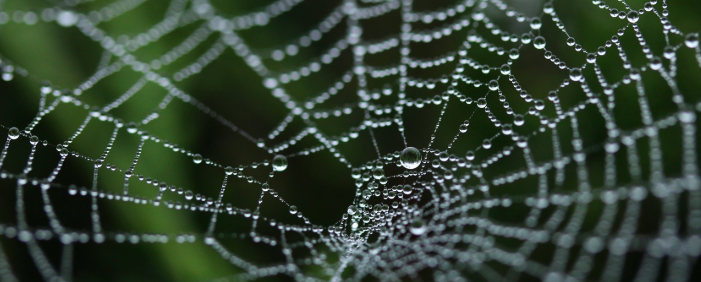
Spider silk has exceptional qualities that scientists would like to reproduce. Before that, one must understand the mechanism that governs its formation. And a Japanese team seems to have taken a step further in this direction.
Extremely resistant and at the same time, surprisingly flexible, spider silk intrigues as much as it interests the researchers. Because such silk, produced on a large scale, could find many applications. It is still necessary to understand the mechanisms of its formation. And that’s what scientists at Riken , a Japanese research institute, think they’ve done.
It should be remembered that the spidery thread produced by spiders is composed, almost two thirds, of filamentous proteins – fibroids – themselves formed in particular by a stack of beta sheets . These are precisely the leaflets that give the spider silk its extraordinary resistance . Scientists have therefore wondered about their training.From soluble phase to beta sheets
Thanks to the help of advanced methods, these Japanese researchers managed to analyze the basic proteins of these beta sheets, in their soluble phase. They discovered, between the terminal elements of these proteins already characterized elsewhere, essentially two types of recurring patterns. One of them, type II polyproline propellers, seems to play a fundamental role.
These propellers, indeed, would be able to form a rigid structure that can then quickly turn into a beta sheet. All in response to changes that occur in the biochemical environment ( dehydration , etc.). And contrary to what the researchers suspected, the pH of the medium does not seem to affect the formation of these beta sheets.
Why is spider silk so resistant?
Spider silk draws its elasticity and resistance from its particular and complex composition. Today, researchers seem to have pierced its secrets and now have the keys to artificially recreate a material of the same resistance.
Solid like steel , stronger than aramid fiber (better known as Kevlar ) for a lower density than cotton or nylon . This amazing material exists, and is none other than spider silk. On a canvas , each wire can absorb large amounts of energy without breaking, as in the impact of aflying insect .
All these unique qualities have long dreamed scientists, who would like to recreate these properties artificially to make objects very resistant. But even today, artificial fibers do not reach the qualitative level of natural fibers, and arachnids cultivated for this purpose become extinct. It is therefore necessary to better understand the origins of the incredible properties of spider silk , a secret finally discovered by biophysicists from the Institute for Theoretical Studies based in Heidelberg, Germany.
Silk: an intermingling of two peptides
Like the silkworm , the spider fiber consists of a subtle mixture of two components: one crystalline and the other amorphous . The crystalline element, which represents about 10 to 25% of the fiber, is formed from the assembly of small peptides of 6 to 10 amino acids containing repeats of alanine or alanine and glycine . These peptides are organized in crystals of 2 to 5 nanometers by side, thanks to hydrogen bonds between different layers of superimposed amino acids (which form the structure called β sheet).
Unlike its acolyte, the amorphous component does not consist of an organized molecule network. The peptides that constitute it are longer and richer in amino acid glycine, and their stacking seems random. If the amorphous component is necessary for the elasticity of the silk , and ensures the distribution of the tension all along the wire, the crystals, in turn, make the structure solid.
Two models to understand the origin of the resistance
To better understand the role and interactions between the two types of material, the researchers used two modeling tools at two different scales. The first is the molecular dynamics simulation, which allows to model the motion of a group of atoms in time. Knowing the exact sequences of the proteins involved in the two components of the silk of the diadem epee ( Araneus diadematus ) and the respective interactions of each of the 300,000 atoms taken into account, a mathematical calculus based on algorithms can imagine them in action.
In addition to the atomic scale, a second modeling method (finite element method), this time focusing on the global scale of the silk thread was used. It is commonly used to ideally represent objects in the form of mesh, where each mesh has particular and known parameters. Concretely, the resistance of a car to a shock can be modeled in this way, thanks to the calculations making it possible to observe the rearrangement of the mesh.
This dual approach, applied to the modeling of different architectures of silk fiber, has enabled researchers to show that the best resistance is obtained when the crystalline and amorphous components follow one another in the form of stacked discs, rather than when they associate randomly. These results, published in the journal Biophysical Journal , should then help to artificially recreate this unique material that continues to fascinate.